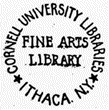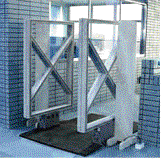Security Measures
Libraries and archives must have safety and security plans in place to ensure that staff are prepared to respond to fire, water emergencies, and other large-scale threats to collections.
Emergency and disaster planning in the library is essential. A library or archives emergency or disaster plan is but one element in a larger safety and security strategy to guide the entire institution’s policies and procedures during such events as wars, terrorist actions, criminal acts, natural disasters, structural fires, serious medical emergencies, or releases of dangerous fumes and gases. Developing a manual of procedures to anticipate all these threats to the entire institution (for example, a university campus in the case of an academic library) is a process in which librarians and archivists must participate.
History has shown the wisdom of taking precautions before events that no one wants to happen or can imagine happening—whether war or any other catastrophe likely to affect the entire structure of an institution and the security of its collections. Advance planning can significantly reduce the loss of rare materials.
Taking precautions against theft
Protecting the collection should include ensuring good security to prevent theft. This is especially a concern when libraries and archives must provide remote storage for overflow materials or special cold storage facilities for vulnerable materials such as microfilm, motion picture film, and film and color negatives.
Inventory control
The essence of theft prevention is inventory control and vigilance. If a library is uncertain about the types and quantities of materials it has in its possession, determining whether and when a theft has been committed will be almost impossible. If library materials are not clearly identified and described, proof of ownership will be difficult to establish even if stolen materials are discovered in someone’s possession.
If possible, inventories can help determine the state of completeness of the collection. If the collection is too large for a full inventory, parts of the collection can be inventoried on a rotating schedule, with special collections of rare and unique materials being checked on a regular basis.
Marks of ownership
All library and archive materials should be clearly identified with a mark of ownership. This ownership mark not only identifies artifacts as the property of the library, but also discourages theft, especially if the mark is not readily removable. Indelible marks are especially important, since staff commit most thefts from rare book and manuscript collections.
Marks of ownership should be made with a prominent and permanent ink stamp on an inseparable portion of the artifact. Generally the stamp should be small (no more than 2 centimeters),  and the ink made from a nongreasy, nonoily substance. In books the mark is typically placed on the verso (back) of the title page. Bookplates, perforated stamps, and pressure stamps can easily be removed and are not effective. The mark should clearly state the name and general address of the library owning the artifact.
and the ink made from a nongreasy, nonoily substance. In books the mark is typically placed on the verso (back) of the title page. Bookplates, perforated stamps, and pressure stamps can easily be removed and are not effective. The mark should clearly state the name and general address of the library owning the artifact.
 If a tasteful, appropriate stamp is used, and applied in a way that does not disfigure the artifact, the mark can be considered an important piece of provenance. For this reason, dealers likely to be offered a stolen item bearing the mark will be made aware of its existence and meaning.
If a tasteful, appropriate stamp is used, and applied in a way that does not disfigure the artifact, the mark can be considered an important piece of provenance. For this reason, dealers likely to be offered a stolen item bearing the mark will be made aware of its existence and meaning.
Accessibility and use
Access to secure storage areas must be carefully monitored. Cleaning, maintenance, and janitorial staff should always be admitted in the company of a staff member, and unauthorized visitors should never be left alone in storage areas. Allowing a potential thief unsupervised access to library materials is potentially encouraging theft. In general, the more knowledgeable the visitor, the greater the risk to the collection.
Ideally, user areas should be separated from secure collection areas by a locked door that can be opened only by an electronic keypad or a magnetized card. Readers using rare or unique materials should be closely supervised at all times to ensure that works or portions of works are not stolen or damaged, intentionally or accidentally.
Works consisting of multiple parts, such as unbound periodicals or collections of letters, should be allotted to readers one piece at a time. When artifacts are issued in a protective enclosure, the contents of the enclosure should be checked when returned by the reader. Permanent records should be made of all uses of rare and unique materials, and readers should be required to verify their identity and affiliation.
Readers working with original and microfilm materials should be checked to ensure that they use only soft pencils for taking notes (the library should make soft pencils available for readers to encourage their use). Staff should make sure that readers understand how to handle library materials correctly, and should be ready to supply cotton gloves when they are required.
Guarding against mutilation and vandalism
Whether a library uses open stacks (allowing readers direct access to the bookshelves) or closed stacks (requiring readers to locate a book in the catalog and rely on staff to retrieve it), staff need to observe readers from time to time to discourage deliberate mutilation or vandalism of library materials. Mutilation often takes the form of cutting out book leaves or illustration.
Protecting materials in book drops
Some libraries, especially those serving the general public, use book drops so that readers may return books when the library is closed. Using book drops is best avoided, but if the circumstances require it the following recommendations should be implemented
The drop should be a hinged slot in the wall or door of the building, to avoid the risk of damage that curbside book drops can suffer when struck by a motor vehicle or engulfed by a street flood. The books should drop no more than 20 centimeters, and they should land on a spring-loaded surface that allows the books to sink into a box container. The entire book drop structure should be in a metal container to prevent arsonists from setting the building on fire through the slot.
Protecting materials on exhibit
Materials on exhibit are especially vulnerable to theft and mutilation. Exhibits featuring rare or other special materials can attract thieves or vandals.
Exhibit cases should be within a controlled area so that they are under surveillance, and safely secured when the control point is closed. The cases should be securely locked and constructed from materials difficult to dismantle or damage. For example, rather than ordinary glass, which can be easily broken, a sturdy plastic sheet should be used, such as Lexan, Plexiglas, or Perspex. Libraries sometimes connect exhibit cases to an alarm system to further discourage theft.
Flat exhibit cases should never be in areas where drinks or other liquids are available, as a carelessly placed container can spill into the case through the seams on the upper surface.
Artifacts displayed in wall-mounted frames should similarly be within a controlled area. The frames should be constructed from materials that are difficult to breach and secured to the wall by a method that requires considerable effort to remove.
Controlling entrances and exits
Ideally, all bags and coats should be checked at the entrance to libraries, which should ensure that there are safe areas for storing them. And while it is acceptable for readers to bring laptop computers into a research area, all readers should understand that their computer case must be checked when they leave the area.
 If possible, libraries should use an electronic detection system at the exit to prevent unauthorized removal of books tagged with magnetized strips. If that is not possible, libraries should have some system for examining the status of books removed for circulation. Libraries operating with open windows should ensure that the window openings are secured with tightly fitting insect screens to prevent thieves from tossing books outside.
If possible, libraries should use an electronic detection system at the exit to prevent unauthorized removal of books tagged with magnetized strips. If that is not possible, libraries should have some system for examining the status of books removed for circulation. Libraries operating with open windows should ensure that the window openings are secured with tightly fitting insect screens to prevent thieves from tossing books outside.